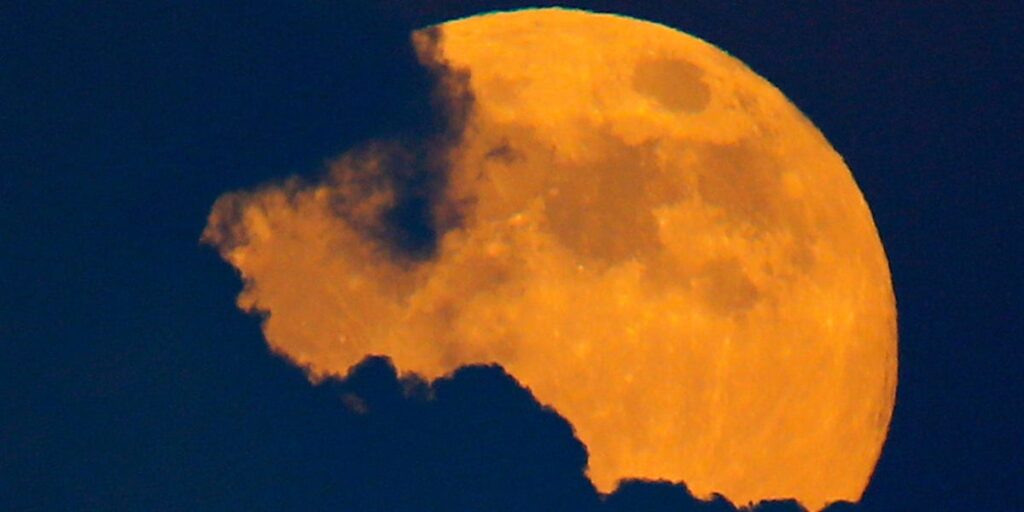There are a couple of reasons to check out the upcoming harvest moon. First, it’s a supermoon, meaning it will appear slightly bigger and brighter in the night sky than a typical full moon.
Second, it coincides with the last partial lunar eclipse of the year. So, depending on your location, you’ll be able to see Earth’s shadow sweep across a small part of the harvest moon when it rises Tuesday evening.
The best time to watch the super harvest moon and partial lunar eclipse
The harvest moon is the full moon that occurs nearest to the first day of autumn. It typically rises in the early evening around sunset, which meant farmers could finish harvesting their fall crops by its bright moonlight, hence the name.
This year, the harvest moon will officially be at its fullest on September 17 at 10:35 p.m. ET, according to NASA. But the harvest moon will appear full for about three days from Monday evening through Thursday morning, NASA adds.
The best time to catch any full moon, including the harvest moon, is right around moonrise.
That’s because the moon looks larger and adopts a yellow-orangish hue when it’s close to the horizon. No one knows why this illusion occurs, according to NASA, but it makes for some spectacular moon gazing and photos.
The moon will rise over the east horizon around 7 p.m. local time on Tuesday for most of the contiguous US, but check TimeandDate for exactly when moonrise is in your area. Here’s when the full harvest moon will rise Tuesday in the five largest US cities:
Also happening Tuesday evening is a partial lunar eclipse. The eclipse will start at 8:41 p.m. ET, according to NASA, but you likely won’t see anything happen until closer to the eclipse’s peak at 10:44 p.m. ET, when the maximum area of the moon’s surface will be in shadow.
A partial lunar eclipse is when Earth passes between the sun and moon, casting its shadow across a certain percentage of the lunar surface. The more the Earth, sun, and moon are aligned, the greater portion of the moon the Earth eclipses.
For this particular eclipse, about 8.4% of the moon will be immersed in shadow, per NASA. So, at the time of the eclipse’s peak, you should be able to notice that a small sliver looks like it’s missing from the top of the moon.
“The only impact the eclipse has on seeing the moon is that part of the moon will be dimmer than the part that is outside of the shadow of the Earth,” Noah Petro, a research scientist at NASA’s Goddard Space Flight Center, told BI over email.
Tuesday’s partial eclipse is the last lunar eclipse of the year. The next lunar eclipse will be a total eclipse on March 14, 2025.
Just about everyone worldwide can enjoy the upcoming supermoon but only regions of North America, South America, Europe, and Africa will have a chance to see the lunar eclipse. TimeandDate has a map showing which portions of the globe will get the best eclipse show.
The harvest moon is the second supermoon of 2024
This year’s harvest moon is the second in a series of four consecutive supermoons, according to EarthSky.
Supermoons occur when a full (or new) moon coincides with perigee — the point in the moon’s orbit when it’s closest to Earth.
But that distance isn’t always the same value because the moon’s orbit is elliptical, not perfectly circular. Therefore, supermoons vary in how much larger and brighter they may look.
In general, though, supermoons appear about 7% larger and 15% brighter than a typical full moon, Larry Wasserman, an astronomer at Lowell Observatory in Arizona, told Business Insider via email.
This year’s harvest moon will be about 222,131 miles from Earth at perigee. To compare, the closest supermoon so far this century, in November 2016, was at a distance of 221,524 miles, according to EarthSky.
The next two full moons, on October 17 and November 15, will also be supermoons. In particular, October’s full moon — called the Hunter’s moon — will be the largest supermoon of the year.
Read the full article here
















